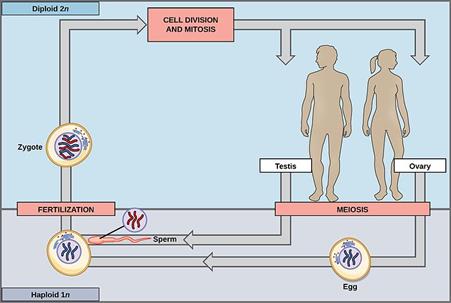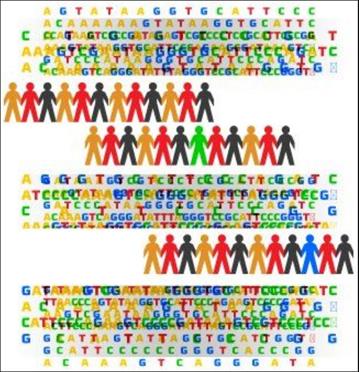PDF chapter test TRY NOW
Variations in sexual reproduction
In higher organisms, sexual reproduction is the primary mode of reproduction. Two parents are involved in sexual reproduction because gametes from two different individuals are fused. Due to this, their genes become mixed up, resulting in many variants in their progeny. As a result, offspring differ from their parents in appearance. This degree of dissimilarity between the young ones and parents is called variation.

Fusion of haploid gametes to form a diploid zygote
The genetic continuity is maintained by passing on the variation accrued in children from generation to generation. These differences can be seen from generation to generation.
Heredity is the term for the phenomena of showing inheritance. There are certain similarities and differences between parents and their offspring as a function of heredity.
Inheritance refers to the passing down of traits and variations from one generation to the next.
Characteristics that are passed down through generations are known as inherited traits.
Characteristics that are passed down through generations are known as inherited traits.
Example:
Skin colour, eye colour, hair colour, height, ear lobes, and eyebrows are among the most widely noticed inherited characteristics in humans.
Apart from these visible characteristics, offspring inherit anatomical characteristics from their parents, such as blood grouping. Some behavioural traits, such as hand use, walking patterns, and intelligence, appear to be passed down from generation to generation.
Dominant and recessive traits in human beings
Advantages of sexual reproduction
- It promotes variation in the progeny.
- Because of their diversity, the species can adapt to different habitats, giving them a survival advantage.
- Individuals in a population are less likely to be affected by the disease.
Disadvantages of sexual reproduction
- Finding a spouse takes time and energy.
- An isolated individual will not be able to do so.
Why is variation needed for an organism?
Each organism reproduces to maintain its life on earth. Do you think all of these species variants have an equal chance of survival in the environment?
The answer is no. we understand that the environment is not the same everywhere. We must adapt to any adversity; variation is required as environmental conditions such as temperature, climate, humidity resources, and so on change. Evolutionary processes are based on the selection of variations by environmental factors.
If we take an example, unicellular organisms like Archaebacteria can withstand heat and survive better in a heatwave.
As we studied in previous classes, meiosis forms a DNA different from the parent cell due to the crossing over and recombination process. A change in DNA information indicates the initiation of variation.

Illustration of genetic variations in species
Advantages of variations:
We can determine the similarities and differences in an individual offspring since the variation is a complex process. Variations have a wide range of benefits.
The following are some of the reasons why it is essential to demonstrate variations.
- Evolution happens because of variation in an individual.
- We can distinguish offspring of single parents based on differences, whether they reproduce sexually or asexually.
- Due to variations, hybrids are produced: different animal and plant varieties can be formed.
- From generation to generation, variations lead to the base of healthy genes.
- With the help of variations, it is possible to adapt to any situation.
- It aids in the selection of the most desirable trait.
Genetic variation causes chromosome linkages to disintegrate, resulting in mutations. Natural selection can use genetic variation to raise or decrease the frequency of alleles already present in the population, an influential factor in evolution. Mutations cause genetic variation by altering genes and alleles in a population. They could affect a single gene or an entire chromosome.
Reference:
https://commons.wikimedia.org/wiki/File:Figure_11_02_01.jpg
https://upload.wikimedia.org/wikipedia/commons/2/2c/Human_genetic_variation.jpg
